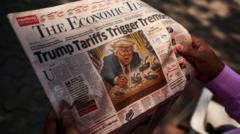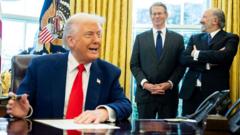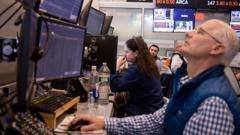India's economy recorded a disappointing 5.4% growth between July and September, marking a significant drop from previous quarters and challenging its status as the fastest-growing major economy. Factors contributing to this slowdown include weak consumer demand, high inflation, stagnant wages, and a cautious approach from the Reserve Bank of India on interest rates.
India’s Growth Momentum: Is It Slowing Down?

India’s Growth Momentum: Is It Slowing Down?
As India reports a lower-than-expected GDP growth rate, experts debate the factors behind potential economic sluggishness and its implications for the future.
India's economy has recently experienced a notable decline, posting a growth rate of just 5.4% between July and September, the lowest in seven quarters. This figure falls short of the Reserve Bank of India’s forecast of 7%, raising pressing questions about the stability of the nation's growth trajectory. While still positioned ahead of many developed countries, the slowdown sparks concern among economists about a potential long-term trend.
Several interconnected factors are contributing to this economic contraction. Consumer demand, a vital element for sustaining growth, has weakened, while private investment has remained stagnant for several years. Government spending, which has played a critical role in spurring economic activity, has also been curtailed. The export sector cannot be overlooked either; India's global share of goods exports hovers at a concerning 2% in 2023.
The retail sector reflects these broader trends with fast-moving consumer goods companies reporting lackluster sales figures. Even in the corporate sector, salary expenditures at publicly listed companies have declined recently, signaling decreased urban income levels. Rajeshwari Sengupta, an economist, captures the sentiment, stating, "There's a clear slowdown and a serious demand problem."
Finance Minister Nirmala Sitharaman presents a more optimistic perspective, attributing the decline to reduced government spending amid an election-driven quarter, suggesting that the economy may rebound in the third quarter. She insists that India will continue to be the fastest-growing economy, despite the looming challenges, which include stagnant wages, a slowdown in global demand, and disruptions in agriculture due to climate issues.
Inflation remains a crucial concern; it spiked to 6.2% in October, breaching the Reserve Bank's target of 4%. The surge has been largely driven by escalating food prices, which represent half of the consumer price index. As prices for essentials like vegetables surged over 40%, many question if the central bank's interest rate policies are stifling growth by making borrowing prohibitively expensive.
While interest rates have remained unchanged for nearly two years to combat inflation, observers argue that simply lowering rates won't stimulate growth unless consumer demand rebounds. As noted by Himanshu, a development economist, "Investors will only borrow and invest when demand exists, and that’s not happening right now."
Notably, as the RBI takes measures to stabilize the rupee—selling $50 billion from its forex reserves—the additional liquidity squeeze raises further questions about the effectiveness of current economic policies. Critics argue that high tariffs, which have risen from an average of 5% to 17%, could impede competitiveness in global markets further exacerbating the economic malaise.
Signs of weakening demand are evident, with car sales plummeting by 14% in November. Sengupta describes the economy as operating on a "two-speed trajectory," where the older sectors, reliant on the informal economy, lag behind the newer services sector, which thrived during the post-COVID recovery.
Despite the disparities, the Indian government maintains an upbeat view, asserting that strong banking sectors and declining extreme poverty signal a resilient economy. Chief economic adviser V Anantha Nageswaran advises against overreacting to the latest GDP numbers, suggesting that India's underlying growth story remains intact.
Ultimately, the challenge for India will be to sustain higher growth rates to foster job creation and elevate incomes. Some experts call for enhanced government-driven employment schemes to uplift wages, while others advocate reducing tariffs to attract more export investments. As India wades through these economic complexities, skepticism remains concerning its ability to fulfill ambitious growth targets, highlighting a crucial time for introspection and policy recalibrations.






















